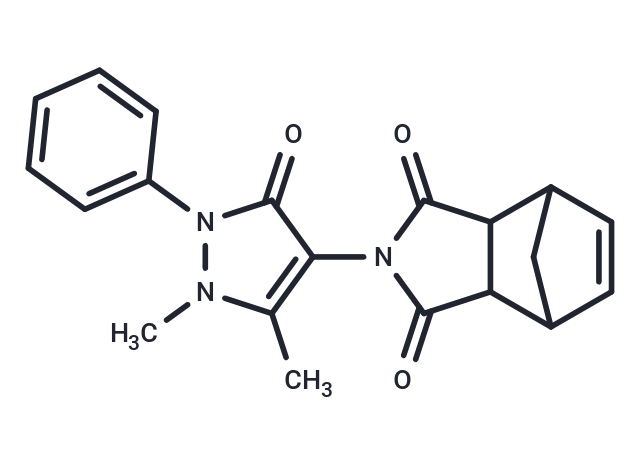Shopping Cart
- Remove All
 Your shopping cart is currently empty
Your shopping cart is currently empty

ZIM, a norbornene derivative of 4-Aminoantipyrine, effectively induces DNA damage, leading to genomic and chromosomal alterations, cell death, and phagocytosis activation. Its properties highlight its potential as a chemotherapeutic agent in cancer research.

| Pack Size | Price | Availability | Quantity |
|---|---|---|---|
| 5 mg | $33 | In Stock | |
| 10 mg | $53 | In Stock | |
| 25 mg | $107 | In Stock | |
| 50 mg | $178 | In Stock | |
| 100 mg | $286 | In Stock | |
| 200 mg | $418 | In Stock | |
| 1 mL x 10 mM (in DMSO) | $48 | In Stock |
| Description | ZIM, a norbornene derivative of 4-Aminoantipyrine, effectively induces DNA damage, leading to genomic and chromosomal alterations, cell death, and phagocytosis activation. Its properties highlight its potential as a chemotherapeutic agent in cancer research. |
| In vivo | ZIM (i.p., 12, 24, and 48 mg/kg) significantly reduces chromosomal micronucleus frequency at all doses in adult male Swiss mice, exhibiting a chemopreventive effect within 24 to 72 hours, and achieving damage reduction between 38.36% and 83.26%.[1] Additionally, ZIM at these concentrations lowers liver and kidney cell death induced by cisplatin-CIS and doxorubicin-DOX, with a decrease in liver damage in the CIS group of 79.27%, 75.20%, and 52.84%, respectively, and 62.06%, 59.44%, and 77.80% in the DOX group. The reduction in kidney damage in the CIS group is 45.29%, 36.09%, and 41.61%, respectively, and in the DOX group, it is 28.00%, 21.41%, and 30.82%.[1] |
| Molecular Weight | 349.38 |
| Formula | C20H19N3O3 |
| Cas No. | 301298-87-3 |
| Smiles | CN1N(C(=O)C(N2C(=O)C3C4CC(C=C4)C3C2=O)=C1C)C1=CC=CC=C1 |
| Storage | Powder: -20°C for 3 years | In solvent: -80°C for 1 year | Shipping with blue ice. | |||||||||||||||||||||||||
| Solubility Information | DMSO: 10 mg/mL (28.62 mM), Sonication is recommended. | |||||||||||||||||||||||||
Solution Preparation Table | ||||||||||||||||||||||||||
DMSO
| ||||||||||||||||||||||||||

Copyright © 2015-2025 TargetMol Chemicals Inc. All Rights Reserved.